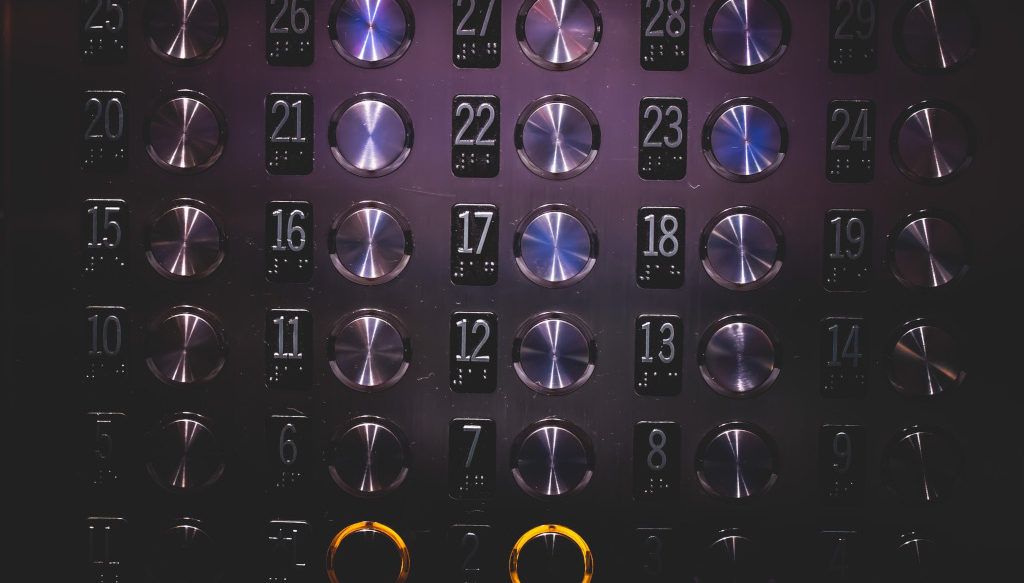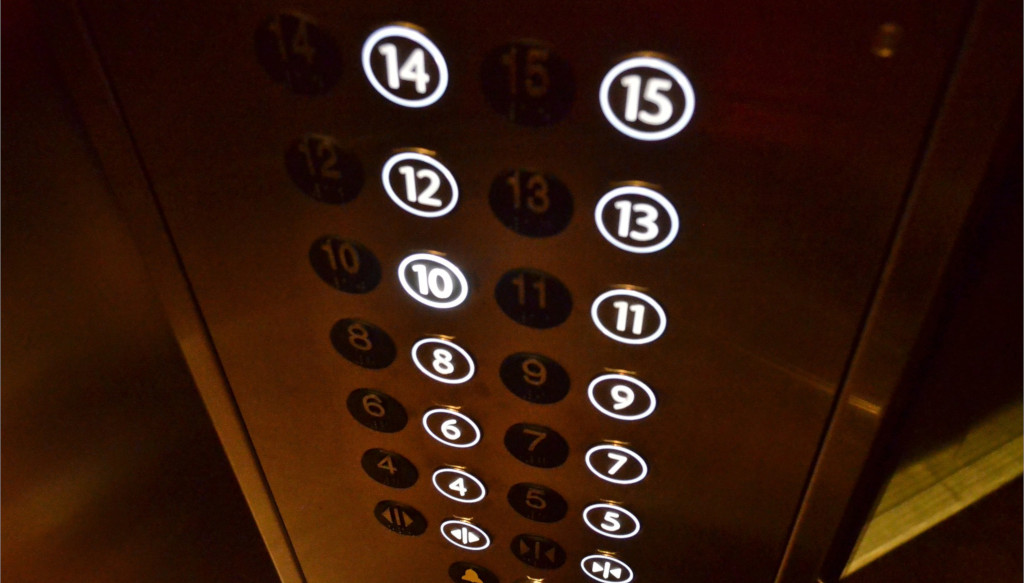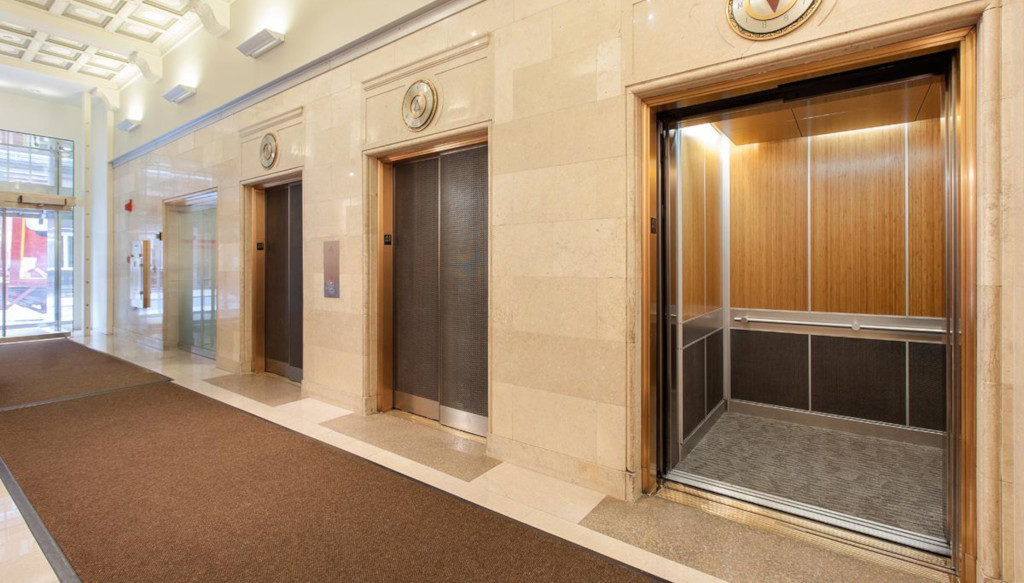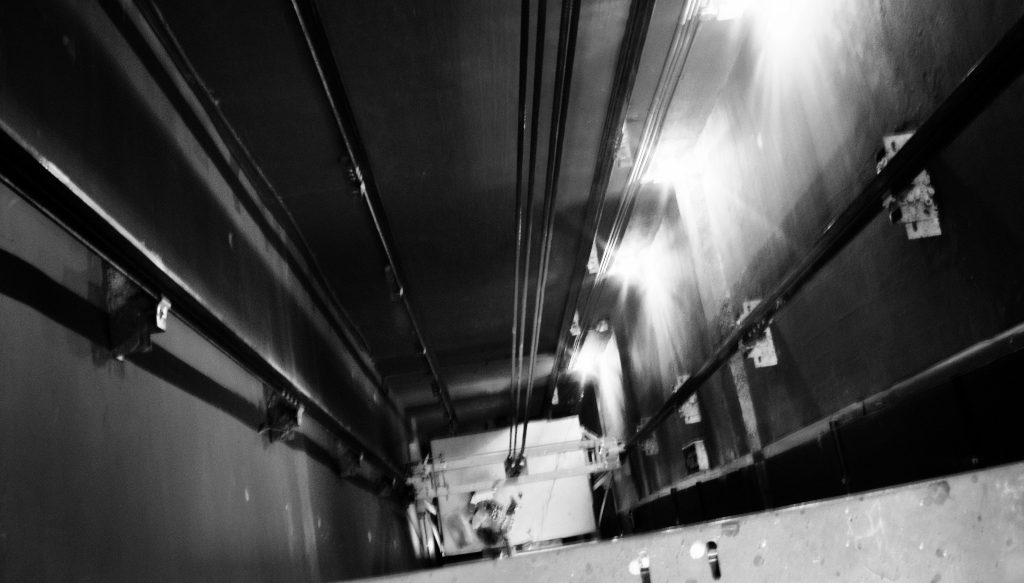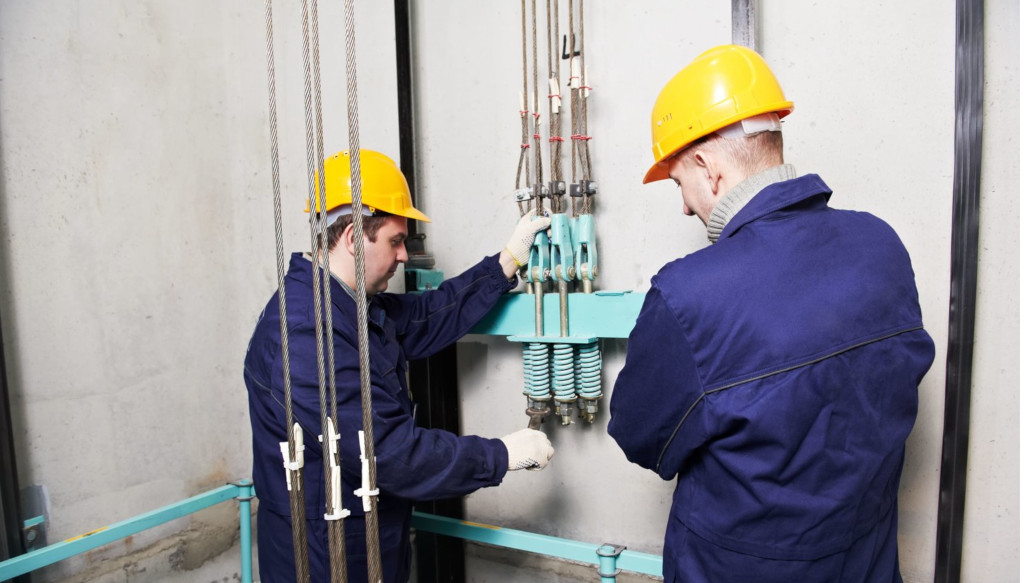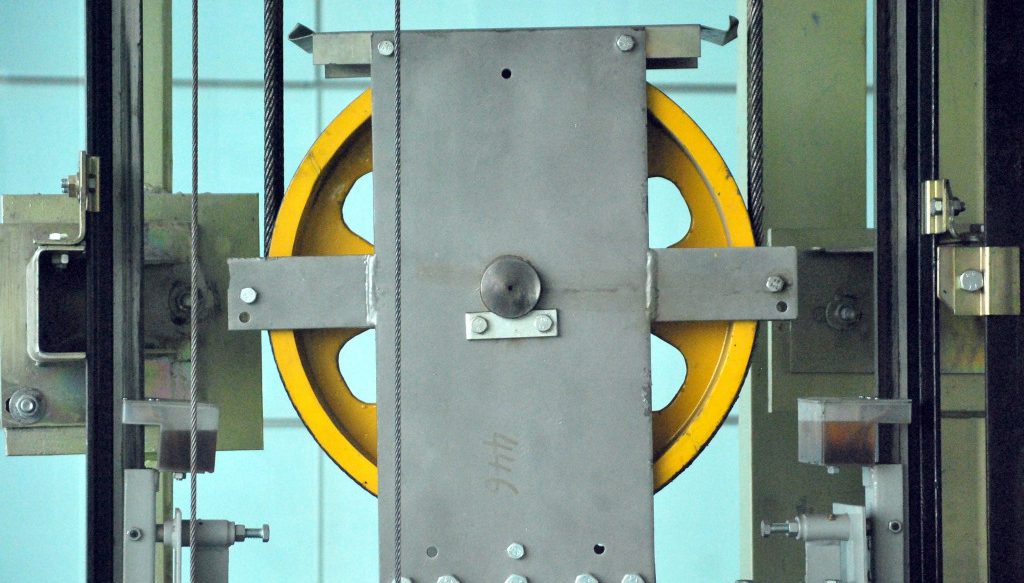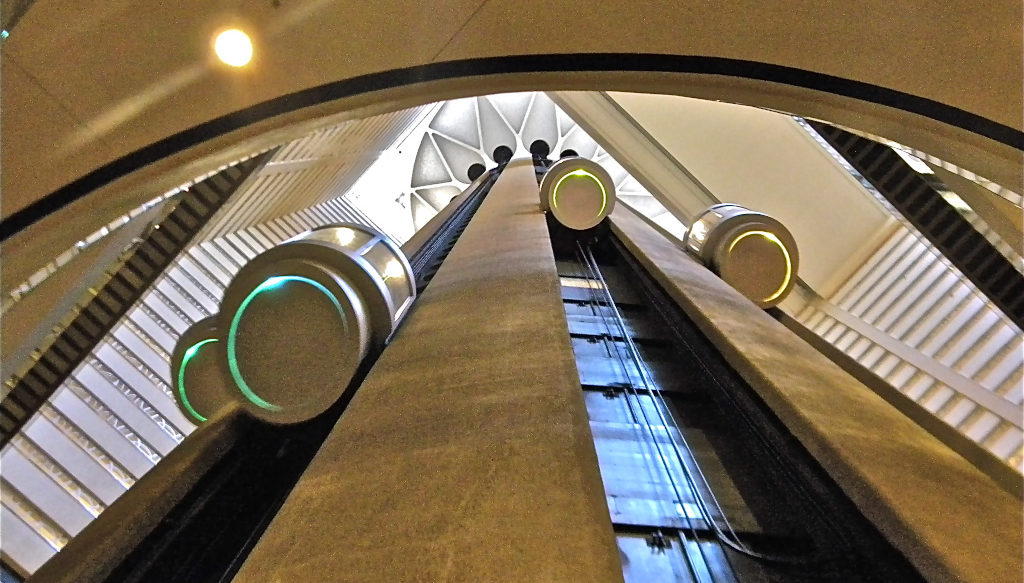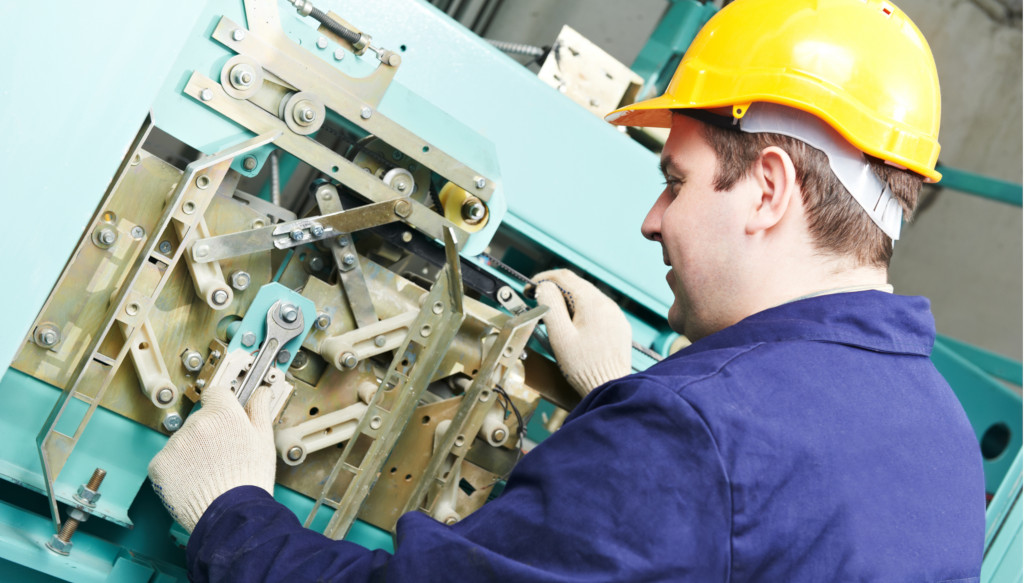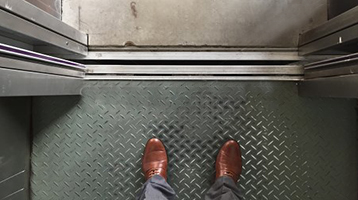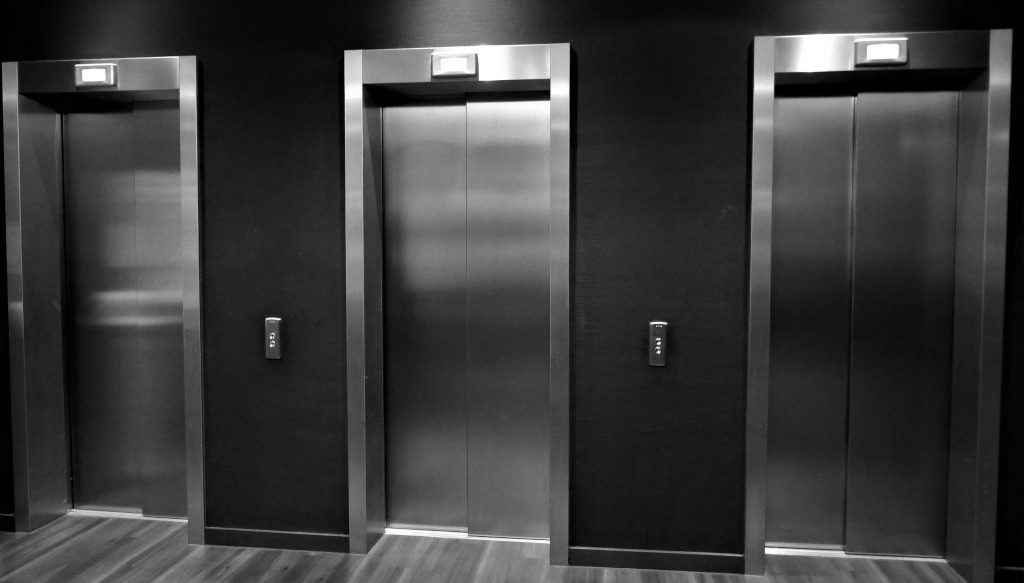DIRECTIVE 2014/33/EU OF THE EUROPEAN PARLIAMENT AND OF THE COUNCIL
of 26 February 2014
CHAPTER I
GENERAL PROVISIONS
Article 1
Scope
1. This Directive shall apply to lifts permanently serving buildings and constructions and intended for the transport of:
(a) persons;
(b) persons and goods;
(c) goods alone if the carrier is accessible, that is to say a person may enter it without difficulty, and fitted with controls situated inside the carrier or within reach of a person inside the carrier.
This Directive shall also apply to the safety components for lifts listed in Annex III for use in the lifts referred to in the first subparagraph.
2.This Directive shall not apply to:
(a) lifting appliances whose speed is not greater than 0,15 m/s;
(b) construction site hoists;
(c) cableways, including funicular railways;
(d) lifts specially designed and constructed for military or police purposes;
(e) lifting appliances from which work can be carried out;
(f) mine winding gear;
(g) lifting appliances intended for lifting performers during artistic performances;
(h) lifting appliances fitted in means of transport;
(i) lifting appliances connected to machinery and intended exclusively for access to workstations including maintenance and inspection points on the machinery;
(j) rack and pinion trains;
(k) escalators and mechanical walkways.
3.Where, for lifts or safety components for lifts, the risks referred to in this Directive are wholly or partly covered by specific Union law, this Directive shall not apply or shall cease to apply in the case of such lifts or safety components for lifts and such risks as from the application of that specific Union law.
Article 2
Definitions
For the purposes of this Directive, the following definitions shall apply:
(1) ‘lift’ means a lifting appliance serving specific levels, having a carrier moving along guides which are rigid and inclined at an angle of more than 15 degrees to the horizontal, or a lifting appliance moving along a fixed course even where it does not move along rigid guides;
(2) ‘carrier’ means a part of the lift by which persons and/or goods are supported in order to be lifted or lowered;
(3) ‘model lift’ means a representative lift whose technical documentation shows the way in which the essential health and safety requirements set out in Annex I will be met for lifts which conform to the model lift defined by objective parameters and which uses identical safety components for lifts;
(4) ‘making available on the market’ means any supply of a safety component for lifts for distribution or use on the Union market in the course of a commercial activity, whether in return for payment or free of charge;
(5) ‘placing on the market’ means:
— the first making available on the market of a safety component for lifts, or
— the supply of a lift for use on the Union market in the course of a commercial activity, whether in return for payment or free of charge;
(6) ‘installer’ means the natural or legal person who takes responsibility for the design, manufacture, installation and placing on the market of the lift;
(7) ‘manufacturer’ means any natural or legal person who manufactures a safety component for lifts or has a safety component for lifts designed or manufactured, and markets it under his name or trade mark;
(8) ‘authorised representative’ means any natural or legal person established within the Union who has received a written mandate from an installer or a manufacturer to act on his behalf in relation to specified tasks;
(9) ‘importer’ means any natural or legal person established within the Union who places a safety component for lifts from a third country on the Union market;
(10) ‘distributor’ means any natural or legal person in the supply chain, other than the manufacturer or the importer, who makes a safety component for lifts available on the market;
(11) ‘economic operators’ means the installer, the manufacturer, the authorised representative, the importer and the distributor;
(12) ‘technical specification’ means a document that prescribes technical requirements to be fulfilled by a lift or a safety component for lifts;
(13) ‘harmonised standard’ means harmonised standard as defined in point (c) of point 1 of Article 2 of Regulation (EU) No 1025/2012;
(14) ‘accreditation’ means accreditation as defined in point 10 of Article 2 of Regulation (EC) No 765/2008;
(15) ‘national accreditation body’ means national accreditation body as defined in point 11 of Article 2 of Regulation (EC) No 765/2008;
(16) ‘conformity assessment’ means the process demonstrating whether the essential health and safety requirements of this Directive relating to a lift or a safety component for lifts have been fulfilled;
(17) ‘conformity assessment body’ means a body that performs conformity assessment activities including calibration, testing, certification and inspection;
(18) ‘recall’ in relation to a lift means any measure aimed at achieving the dismantling and safe disposal of a lift, and in relation to a safety component for lifts means any measure aimed at achieving the return of a safety component for lifts that has already been made available to the installer or to the end-user;
(19) ‘withdrawal’ means any measure aimed at preventing a safety component for lifts in the supply chain from being made available on the market;
(20) ‘Union harmonisation legislation’ means any Union legislation harmonising the conditions for the marketing of products;
(21) ‘CE marking’ means a marking by which the installer or the manufacturer indicates that the lift or safety component for lifts are in conformity with the applicable requirements set out in Union harmonisation legislation providing for its affixing.
Article 3
Free movement
1.Member States shall not prohibit, restrict or impede the placing on the market or putting into service of lifts or the making available on the market of safety components for lifts on their territory which comply with this Directive.
2.At trade fairs, exhibitions or demonstrations Member States shall not prevent the showing of lifts or safety components for lifts which are not in conformity with this Directive, provided that a visible sign clearly indicates that they are not in conformity and will not be placed or made available on the market until they have been brought into conformity. During demonstrations, adequate safety measures shall be taken to ensure the protection of persons.
3.This Directive shall not affect Member States’ entitlement to lay down in conformity with the Union law such requirements as they may deem necessary to ensure that persons are protected when the lifts in question are put into service or used, provided that this does not mean that the lifts are modified in a way not specified in this Directive.
Article 4
Placing on the market, making available on the market and putting into service
1.Member States shall take all appropriate measures to ensure that the lifts covered by this Directive may be placed on the market and put into service only if they comply with this Directive, when properly installed and maintained and used for their intended purpose.
2.Member States shall take all appropriate measures to ensure that safety components for lifts covered by this Directive may be made available on the market and put into service only if they comply with this Directive when properly incorporated and maintained and used for their intended purpose.
Article 5
Essential health and safety requirements
1.Lifts covered by this Directive shall satisfy the essential health and safety requirements set out in Annex I.
2.Safety components for lifts covered by this Directive shall satisfy the essential health and safety requirements set out in Annex I and enable the lifts in which they are incorporated to satisfy those requirements.
Article 6
Buildings or constructions in which lifts are installed
1.Member States shall take all appropriate measures to ensure that the person responsible for work on the building or construction and the installer both provide each other with the necessary information and take the appropriate steps in order to ensure the proper operation and safe use of the lift.
2.Member States shall take all necessary measures to ensure that shafts intended for lifts do not contain any piping or wiring or fittings other than that necessary for the operation and safety of the lift.
CHAPTER II
OBLIGATIONS OF ECONOMIC OPERATORS
Article 7
Obligations of installers
1.When placing a lift on the market, installers shall ensure that it has been designed, manufactured, installed and tested in accordance with the essential health and safety requirements set out in Annex I.
2.Installers shall draw up the technical documentation and carry out the relevant conformity assessment procedure referred to in Article 16 or have it carried out.
Where compliance of the lift with the applicable essential health and safety requirements has been demonstrated by that procedure, the installer shall draw up an EU declaration of conformity, ensure that it accompanies the lift, and affix the CE marking.
3.The installer shall keep the technical documentation, the EU declaration of conformity and, where applicable, the approval decision(s) for 10 years after the lift has been placed on the market.
4.When deemed appropriate with regard to the risks presented by a lift, installers shall, to protect the health and safety of consumers, investigate, and, if necessary, keep a register of complaints, and of non-conforming lifts.
5.Installers shall ensure that lifts bear a type, batch or serial number or other element allowing their identification.
6.Installers shall indicate, on the lift, their name, registered trade name or registered trade mark and the postal address at which they can be contacted. The address shall indicate a single point at which the installer can be contacted. The contact details shall be in a language easily understood by end-users and market surveillance authorities.
7.Installers shall ensure that the lift is accompanied by the instructions referred to in point 6.2 of Annex I, in a language which can be easily understood by end-users, as determined by the Member State in which the lift is placed on the market. Such instructions, as well as any labelling, shall be clear, understandable and intelligible.
8.Installers who consider or have reason to believe that a lift which they have placed on the market is not in conformity with this Directive shall immediately take the corrective measures necessary to bring that lift into conformity. Furthermore, where the lift presents a risk, installers shall immediately inform the competent national authorities of the Member States in which they placed the lift on the market to that effect, giving details, in particular, of the non-conformity and of any corrective measures taken.
9.Installers shall, further to a reasoned request from a competent national authority, provide it with all the information and documentation in paper or electronic form necessary to demonstrate the conformity of the lift with this Directive, in a language which can be easily understood by that authority.
They shall cooperate with that authority, at its request, on any action taken to eliminate the risks posed by lifts which they have placed on the market.
Article 8
Obligations of manufacturers
1.When placing their safety components for lifts on the market, manufacturers shall ensure that they have been designed and manufactured in accordance with Article 5(2).
2.Manufacturers shall draw up the required technical documentation and carry out the relevant conformity assessment procedure referred to in Article 15 or have it carried out
Where compliance of a safety component for lifts with the applicable essential health and safety requirements has been demonstrated by that procedure, manufacturers shall draw up an EU declaration of conformity, ensure that it accompanies the safety component for lifts and affix the CE marking.
3.Manufacturers shall keep the technical documentation, the EU declaration of conformity and, where applicable, the approval decision(s) for 10 years after the safety component for lifts has been placed on the market.
4.Manufacturers shall ensure that procedures are in place for series production to remain in conformity with this Directive. Changes in product design or characteristics and changes in the harmonised standards or in other technical specifications by reference to which conformity of a safety component for lifts is declared shall be adequately taken into account.
When deemed appropriate with regard to the risks presented by a safety component for lifts, manufacturers shall, to protect the health and safety of consumers, carry out sample testing of safety component for lifts made available on the market, investigate, and, if necessary, keep a register of complaints, of non-conforming safety components for lifts and recalls of the safety components for lifts, and shall keep distributors and installers informed of any such monitoring.
5.Manufacturers shall ensure that safety components for lifts which they have placed on the market bear a type, batch or serial number or other element allowing their identification, or, where the size or nature of the safety component for lifts does not allow it, that the required information is provided on the label referred to in Article 19(1).
6.Manufacturers shall indicate on the safety component for lifts their name, registered trade name or registered trade mark and the postal address at which they can be contacted or, where that is not possible, on the label referred to in Article 19(1). The address shall indicate a single point at which the manufacturer can be contacted. The contact details shall be in a language easily understood by end-users and market surveillance authorities.
7.Manufacturers shall ensure that the safety component for lifts is accompanied by the instructions referred to in point 6.1 of Annex I, in a language which can be easily understood by end-users, as determined by the Member State concerned. Such instructions, as well as any labelling, shall be clear, understandable and intelligible.
8.Manufacturers who consider or have reason to believe that a safety component for lifts which they have placed on the market is not in conformity with this Directive shall immediately take the corrective measures necessary to bring that safety component for lifts into conformity, to withdraw it or recall it, if appropriate. Furthermore, where the safety component for lifts presents a risk, manufacturers shall immediately inform the competent national authorities of the Member States in which they made the safety components for lifts available on the market to that effect, giving details, in particular, of the non-conformity and of any corrective measures taken.
9.Manufacturers shall, further to a reasoned request from a competent national authority, provide it with all the information and documentation in paper or electronic form necessary to demonstrate the conformity of the safety components for lifts with this Directive, in a language which can be easily understood by that authority.
They shall cooperate with that authority, at its request, on any action taken to eliminate the risks posed by safety components for lifts which they have placed on the market.
Article 9
Authorised representatives
1.A manufacturer or an installer may, by a written mandate, appoint an authorised representative.
The obligations laid down in Article 7(1) or in Article 8(1) and the obligation to draw up technical documentation referred to in Article 7(2) or in Article 8(2) shall not form part of the authorised representative’s mandate.
2.An authorised representative shall perform the tasks specified in the mandate received from the manufacturer or the installer. The mandate shall allow the authorised representative to do at least the following:
(a) keep the EU declaration of conformity and, where applicable, the approval decision(s) relating to the manufacturer’s or the installer’s quality system, and the technical documentation at the disposal of the national market surveillance authorities for 10 years after the safety component for lifts or the lift has been placed on the market;
(b) further to a reasoned request from a competent national authority, provide that authority with all the information and documentation necessary to demonstrate the conformity of the safety components for lifts or the lift;
(c) cooperate with the competent national authorities, at their request, on any action taken to eliminate the risks posed by the safety component for lifts or the lift covered by the authorised representative’s mandate.
Article 10
Obligations of importers
1.Importers shall place only compliant safety components for lifts on the market.
2.Before placing a safety component for lifts on the market, importers shall ensure that the appropriate conformity assessment procedure referred to in Article 15 has been carried out by the manufacturer. They shall ensure that the manufacturer has drawn up the technical documentation, that the safety component for lifts bears the CE marking and is accompanied by the EU declaration of conformity and the required documents, and that the manufacturer has complied with the requirements set out in Article 8(5) and (6).
Where an importer considers or has reason to believe that a safety component for lifts is not in conformity with Article 5(2), he shall not place the safety component for lifts on the market until it has been brought into conformity. Furthermore, where the safety component for lifts presents a risk, the importer shall inform the manufacturer and the market surveillance authorities to that effect.
3.Importers shall indicate on the safety component for lifts their name, registered trade name or registered trade mark and the postal address at which they can be contacted or, where that is not possible, on its packaging or in a document accompanying the safety component for lifts. The contact details shall be in a language easily understood by end-users and market surveillance authorities.
4.Importers shall ensure that the safety component for lifts is accompanied by the instructions referred to in point 6.1 of Annex I in a language which can be easily understood by consumers and other end-users, as determined by the Member State concerned.
5.Importers shall ensure that, while a safety component for lifts is under their responsibility, its storage or transport conditions do not jeopardise its compliance with the essential health and safety requirements referred to in Article 5(2).
6.When deemed appropriate with regard to the risks presented by a safety component for lifts, importers shall, to protect the health and safety of consumers, carry out sample testing of safety components for lifts made available on the market, investigate, and, if necessary, keep a register of complaints, of non-conforming safety components for lifts and recalls of safety components for lifts, and shall keep distributors and installers informed of any such monitoring.
7.Importers who consider or have reason to believe that a safety component for lifts which they have placed on the market is not in conformity with this Directive shall immediately take the corrective measures necessary to bring that safety component for lifts into conformity, to withdraw it or recall it, if appropriate. Furthermore, where the safety component for lifts presents a risk, importers shall immediately inform the competent national authorities of the Member States in which they made the safety component for lifts available on the market to that effect, giving details, in particular, of the non-compliance and of any corrective measures taken.
8.Importers shall, for 10 years after the safety component for lifts has been placed on the market, keep a copy of the EU declaration of conformity and, where applicable, of the approval decision(s) at the disposal of the market surveillance authorities and ensure that the technical documentation can be made available to those authorities, upon request.
9.Importers shall, further to a reasoned request from a competent national authority, provide it with all the information and documentation in paper or electronic form necessary to demonstrate the conformity of a safety component for lifts in a language which can be easily understood by that authority. They shall cooperate with that authority, at its request, on any action taken to eliminate the risks posed by safety components for lifts which they have placed on the market.
Article 11
Obligations of distributors
1.When making a safety component for lifts available on the market distributors shall act with due care in relation to the requirements of this Directive.
2.Before making a safety component for lifts available on the market, distributors shall verify that the safety component for lifts bears the CE marking, that it is accompanied by the EU declaration of conformity, by the required documents and by the instructions referred to in point 6.1 of Annex I, in a language which can be easily understood by end-users, as determined by the Member State concerned and that the manufacturer and the importer have complied with the requirements set out in Article 8(5) and (6) and Article 10(3), respectively.
Where a distributor considers or has reason to believe that a safety component for lifts is not in conformity with Article 5(2), he shall not make the safety component for lifts available on the market until it has been brought into conformity. Furthermore, where the safety component for lifts presents a risk, the distributor shall inform the manufacturer or the importer to that effect as well as the market surveillance authorities.
3.Distributors shall ensure that, while a safety component for lifts is under their responsibility, its storage or transport conditions do not jeopardise its compliance with Article 5(2).
4.Distributors who consider or have reason to believe that a safety component for lifts which they have made available on the market is not in conformity with this Directive shall make sure that the corrective measures necessary to bring that safety component for lifts into conformity, to withdraw it or recall it, if appropriate, are taken. Furthermore, where the safety component for lifts presents a risk, distributors shall immediately inform the competent national authorities of the Member States in which they made the safety component for lifts available on the market to that effect, giving details, in particular, of the non-compliance and of any corrective measures taken.
5.Distributors shall, further to a reasoned request from a competent national authority, provide it with all the information and documentation in paper or electronic form necessary to demonstrate the conformity of a safety component for lifts. They shall cooperate with that authority, at its request, on any action taken to eliminate the risks posed by safety components for lifts which they have made available on the market.
Article 12
Cases in which the obligations of manufacturers apply to importers or distributors
An importer or distributor shall be considered a manufacturer for the purposes of this Directive and he shall be subject to the obligations of the manufacturer under Article 8, where he places a safety component for lifts on the market under his name or trade mark or modifies a safety component for lifts already placed on the market in such a way that compliance with this Directive may be affected.
Article 13
Identification of economic operators
Economic operators shall, on request, identify the following to the market surveillance authorities:
(a) any economic operator who has supplied them with a safety component for lifts;
(b) any economic operator to whom they have supplied a safety component for lifts.
Economic operators shall be able to present the information referred to in the first paragraph for 10 years after they have been supplied with a safety component for lifts and for 10 years after they have supplied a safety component for lifts.
CHAPTER III
CONFORMITY OF LIFTS AND SAFETY COMPONENTS FOR LIFTS
Article 14
Presumption of conformity of lifts and safety components for lifts
Lifts and safety components for lifts which are in conformity with harmonised standards or parts thereof the references of which have been published in the Official Journal of the European Union shall be presumed to be in conformity with the essential health and safety requirements set out in Annex I covered by those standards or parts thereof.
Article 15
Conformity assessment procedures for safety components for lifts
Safety components for lifts shall be subject to one of the following conformity assessment procedures:
(a) the model of the safety component for lifts shall be submitted for EU type examination set out in Annex IV, Part A and the conformity to type shall be ensured with random checking of the safety component for lifts set out in Annex IX;
(b) the model of the safety component for lifts shall be submitted for EU type examination set out in Annex IV, Part A and be subject to conformity to type based on product quality assurance in accordance with Annex VI;
(c) conformity based on full quality assurance set out in Annex VII.
Article 16
Conformity assessment procedures for lifts
1.Lifts shall be subject to one of the following conformity assessment procedures:
(a) if they are designed and manufactured in accordance with a model lift that has undergone an EU-type examination set out in in Annex IV, Part B:
(i) final inspection for lifts set out in Annex V;
(ii) conformity to type based on product quality assurance for lifts set out in Annex X;
(iii) conformity to type based on production quality assurance for lifts set out in Annex XII;
(b) if they are designed and manufactured under a quality system approved in accordance with Annex XI:
(i) final inspection for lifts set out in Annex V;
(ii) conformity to type based on product quality assurance for lifts set out in Annex X;
(iii) conformity to type based on production quality assurance for lifts set out in Annex XII;
(c) conformity based on unit verification for lifts set out in Annex VIII;
(d) conformity based on full quality assurance plus design examination for lifts set out in Annex XI.
2.In the cases referred to in points (a) and (b) of paragraph 1, where the person responsible for the design and manufacture of the lift and the person responsible for the installation and testing of the lift are not the same, the former shall supply to the latter all the necessary documents and information to enable the latter to ensure correct and safe installation and testing of the lift.
3.All permitted variations between the model lift and the lifts forming part of the lifts derived from the model lift shall be clearly specified (with maximum and minimum values) in the technical documentation.
4.By calculation and/or on the basis of design plans it is permitted to demonstrate the similarity of a range of equipment to satisfy the essential health and safety requirements set out in Annex I.
Article 17
EU declaration of conformity
1.The EU declaration of conformity shall state that the fulfilment of the essential health and safety requirements set out in Annex I has been demonstrated.
2.The EU declaration of conformity shall have the model structure set out in Annex II, shall contain the elements specified in the relevant Annexes V to XII, and shall be continuously updated. It shall be translated into the language or the languages required by the Member State in which the lift or the safety component for lifts is placed or made available on the market.
3.Where a lift or a safety component for lifts is subject to more than one Union act requiring an EU declaration of conformity, a single EU declaration of conformity shall be draw up in respect of all such Union acts. That declaration shall contain the identification of the Union acts concerned including their publication references.
4.By drawing up the EU declaration of conformity, the manufacturer shall assume responsibility for the compliance of the safety component for lifts and the installer shall assume responsibility for the compliance of the lift with the requirements laid down in this Directive.
Article 18
General principles of the CE marking
The CE marking shall be subject to the general principles set out in Article 30 of Regulation (EC) No 765/2008.
Article 19
Rules and conditions for affixing the CE marking and other markings
1.The CE marking shall be affixed visibly, legibly and indelibly to each lift car and to each safety component for lifts or, where that is not possible, on a label inseparably attached to the safety component for lifts.
2.The CE marking shall be affixed before the lift or the safety component for lifts is placed on the market.
3.The CE marking on lifts shall be followed by the identification number of the notified body involved in any of the following conformity assessment procedures:
(a) the final inspection referred to in Annex V;
(b) unit verification, referred to in Annex VIII;
(c) quality assurance referred to in Annexes X, XI or XII.
4.The CE marking on safety components for lifts shall be followed by the identification number of the notified body involved in any of the following conformity assessment procedures:
(a) product quality assurance referred to in Annex VI;
(b) full quality assurance referred to in Annex VII;
(c) conformity to type with random checking for safety components for lifts referred to in Annex IX.
5.The identification number of the notified body shall be affixed by the body itself or, under its instructions, by the manufacturer or his authorised representative or by the installer or his authorised representative.
The CE marking and the identification number of the notified body may be followed by any other mark indicating a special risk or use.
6.Member States shall build upon existing mechanisms to ensure correct application of the regime governing the CE marking and shall take appropriate action in the event of improper use of that marking.
CHAPTER IV
NOTIFICATION OF CONFORMITY ASSESSMENT BODIES
Article 20
Notification
Member States shall notify the Commission and the other Member States of bodies authorised to carry out third party conformity assessment tasks under this Directive.
Article 21
Notifying authorities
1.Member States shall designate a notifying authority that shall be responsible for setting up and carrying out the necessary procedures for the assessment and notification of conformity assessment bodies and the monitoring of notified bodies, including compliance with Article 26.
2.Member States may decide that the assessment and monitoring referred to in paragraph 1 shall be carried out by a national accreditation body within the meaning of and in accordance with Regulation (EC) No 765/2008.
3.Where the notifying authority delegates or otherwise entrusts the assessment, notification or monitoring referred to in paragraph 1 to a body which is not a governmental entity, that body shall be a legal entity and shall comply mutatis mutandis with the requirements laid down in Article 22. In addition it shall have arrangements to cover liabilities arising out of its activities.
4.The notifying authority shall take full responsibility for the tasks performed by the body referred to in paragraph 3.
Article 22
Requirements relating to notifying authorities
1.A notifying authority shall be established in such a way that no conflict of interest with conformity assessment bodies occurs.
2.A notifying authority shall be organised and operated so as to safeguard the objectivity and impartiality of its activities.
3.A notifying authority shall be organised in such a way that each decision relating to notification of a conformity assessment body is taken by competent persons different from those who carried out the assessment.
4.A notifying authority shall not offer or provide any activities that conformity assessment bodies perform or consultancy services on a commercial or competitive basis.
5.A notifying authority shall safeguard the confidentiality of the information it obtains.
6.A notifying authority shall have a sufficient number of competent personnel at its disposal for the proper performance of its tasks.
Article 23
Information obligation on notifying authorities
Member States shall inform the Commission of their procedures for the assessment and notification of conformity assessment bodies and the monitoring of notified bodies, and of any changes thereto.
The Commission shall make that information publicly available.
Article 24
Requirements relating to notified bodies
1.For the purposes of notification, a conformity assessment body shall meet the requirements laid down in paragraphs 2 to 11.
2.A conformity assessment body shall be established under national law of a Member State and have legal personality.
3.A conformity assessment body shall be a third-party body independent of the organisation or the lifts or safety components for lifts it assesses.
A body belonging to a business association or professional federation representing undertakings involved in the design, manufacturing, provision, assembly, use or maintenance of lifts or safety components for lifts which it assesses, may, on condition that its independence and the absence of any conflict of interest are demonstrated, be considered such a body.
4.A conformity assessment body, its top level management and the personnel responsible for carrying out the conformity assessment tasks shall not be the designer, manufacturer, supplier, installer, purchaser, owner, user or maintainer of lifts or safety components for lifts which they assess, nor the representative of any of those parties.
This shall not preclude the use of assessed lifts or safety components for lifts that are necessary for the operations of the conformity assessment body or the use of such lifts or safety components for lifts for personal purposes.
This does not preclude the possibility of exchange of technical information between the manufacturer or the installer and the body.
A conformity assessment body, its top level management and the personnel responsible for carrying out the conformity assessment tasks shall not be directly involved in the design, manufacture or construction, the marketing, installation, use or maintenance of those lifts or safety components for lifts, or represent the parties engaged in those activities.
They shall not engage in any activity that may conflict with their independence of judgement or integrity in relation to conformity assessment activities for which they are notified. This shall in particular apply to consultancy services.
A conformity assessment body shall ensure that the activities of its subsidiaries or subcontractors do not affect the confidentiality, objectivity or impartiality of its conformity assessment activities.
5.A conformity assessment body and its personnel shall carry out the conformity assessment activities with the highest degree of professional integrity and the requisite technical competence in the specific field and shall be free from all pressures and inducements, particularly financial, which might influence their judgement or the results of their conformity assessment activities, especially as regards persons or groups of persons with an interest in the results of those activities.
6.A conformity assessment body shall be capable of carrying out all the conformity assessment tasks assigned to it by Annexes IV to XII and in relation to which it has been notified, whether those tasks are carried out by the conformity assessment body itself or on its behalf and under its responsibility.
At all times and for each conformity assessment procedure and each kind or category of lifts or safety components for lifts in relation to which it has been notified, a conformity assessment body shall have at its disposal the necessary:
(a) personnel with technical knowledge and sufficient and appropriate experience to perform the conformity assessment tasks;
(b) descriptions of procedures in accordance with which conformity assessment is carried out, ensuring the transparency and the ability of reproduction of those procedures. It shall have appropriate policies and procedures in place that distinguish between tasks it carries out as a notified body and other activities;
(c) procedures for the performance of activities which take due account of the size of an undertaking, the sector in which it operates, its structure, the degree of complexity of product technology in question and the mass or serial nature of the production process.
A conformity assessment body shall have the means necessary to perform the technical and administrative tasks connected with the conformity assessment activities in an appropriate manner and shall have access to all necessary equipment or facilities.
7.The personnel responsible for carrying out conformity assessment tasks shall have the following:
(a) sound technical and vocational training covering all the conformity assessment activities for which the conformity assessment body has been notified;
(b) satisfactory knowledge of the requirements of the assessments they carry out and adequate authority to carry out those assessments;
(c) appropriate knowledge and understanding of the essential health and safety requirements set out in Annex I, of the applicable harmonised standards and of the relevant provisions of Union harmonisation legislation and of its relevant national legislation;
(d) the ability to draw up certificates, records and reports demonstrating that assessments have been carried out.
8.The impartiality of the conformity assessment body, its top level management and the personnel responsible for carrying out the conformity assessment tasks shall be guaranteed.
The remuneration of the top level management and personnel responsible for carrying out the conformity assessment tasks of the conformity assessment body shall not depend on the number of assessments carried out or on the results of those assessments.
9.Conformity assessment bodies shall take out liability insurance unless liability is assumed by the State in accordance with national law or the Member State itself is directly responsible for the conformity assessment.
10.The personnel of a conformity assessment body shall observe professional secrecy with regard to all information obtained in carrying out their tasks under Annexes IV to XII or any provision of national law giving effect to it, except in relation to the competent authorities of the Member State in which its activities are carried out. Proprietary rights shall be protected.
11.Conformity assessment bodies shall participate in, or ensure that their personnel responsible for carrying out the conformity assessment tasks are informed of, the relevant standardisation activities, as well as the activities of the Coordination Group of Notified Bodies for Lifts established pursuant to Article 36. Conformity assessment bodies shall apply as general guidance the administrative decisions and documents produced as a result of the work of that group.
Article 25
Presumption of conformity of notified bodies
Where a conformity assessment body demonstrates its conformity with the criteria laid down in the relevant harmonised standards or parts thereof the references of which have been published in the Official Journal of the European Union it shall be presumed to comply with the requirements set out in Article 24 in so far as the applicable harmonised standards cover those requirements.
Article 26
Subsidiaries of and subcontracting by notified bodies
1.Where a notified body subcontracts specific tasks connected with conformity assessment or has recourse to a subsidiary, it shall ensure that the subcontractor or the subsidiary meets the requirements set out in Article 24 and shall inform the notifying authority accordingly.
2.Notified bodies shall take full responsibility for the tasks performed by subcontractors or subsidiaries wherever these are established.
3.Activities may be subcontracted or carried out by a subsidiary only with the agreement of the client.
4.Notified bodies shall keep at the disposal of the notifying authority the relevant documents concerning the assessment of the qualifications of the subcontractor or the subsidiary and the work carried out by them under Annexes IV to XII.
Article 27
Application for notification
1.A conformity assessment body shall submit an application for notification to the notifying authority of the Member State in which it is established.
2.The application for notification shall be accompanied by a description of the conformity assessment activities, the conformity assessment procedure or procedures and the lifts or safety components for lifts for which the body claims to be competent, as well as by an accreditation certificate, where one exists, issued by a national accreditation body attesting that the conformity assessment body fulfils the requirements laid down in Article 24.
3.Where the conformity assessment body concerned cannot provide an accreditation certificate, it shall provide the notifying authority with all the documentary evidence necessary for the verification, recognition and regular monitoring of its compliance with the requirements laid down in Article 24.
Article 28
Notification procedure
1.Notifying authorities may notify only conformity assessment bodies which have satisfied the requirements laid down in Article 24.
2.They shall notify the Commission and the other Member States using the electronic notification tool developed and managed by the Commission.
3.The notification shall include full details of the conformity assessment activities, the conformity assessment procedure or procedures and the lifts or the safety components for lifts concerned, and the relevant attestation of competence.
4.Where a notification is not based on an accreditation certificate as referred to in Article 27(2), the notifying authority shall provide the Commission and the other Member States with documentary evidence which attests to the conformity assessment body’s competence and the arrangements in place to ensure that that body will be monitored regularly and will continue to satisfy the requirements laid down in Article 24.
5.The body concerned may perform the activities of a notified body only where no objections are raised by the Commission or the other Member States within two weeks of a notification where an accreditation certificate is used or within two months of a notification where accreditation is not used.
Only such a body shall be considered a notified body for the purposes of this Directive.
6.The notifying authority shall notify the Commission and the other Member States of any subsequent relevant changes to the notification.
Article 29
Identification numbers and lists of notified bodies
1.The Commission shall assign an identification number to a notified body.
It shall assign a single such number even where the body is notified under several Union acts.
2.The Commission shall make publicly available the list of the bodies notified under this Directive, including the identification numbers that have been assigned to them and the activities for which they have been notified.
The Commission shall ensure that the list is kept up to date.
Article 30
Changes to notifications
1.Where a notifying authority has ascertained or has been informed that a notified body no longer meets the requirements laid down in Article 24, or that it is failing to fulfil its obligations, the notifying authority shall restrict, suspend or withdraw notification as appropriate, depending on the seriousness of the failure to meet those requirements or fulfil those obligations. It shall immediately inform the Commission and the other Member States accordingly.
2.In the event of restriction, suspension or withdrawal of notification, or where the notified body has ceased its activity, the notifying Member State shall take appropriate steps to ensure that the files of that body are either processed by another notified body or kept available for the responsible notifying and market surveillance authorities at their request.
Article 31
Challenge to the competence of notified bodies
1.The Commission shall investigate all cases where it doubts, or doubt is brought to its attention, regarding the competence of a notified body or the continued fulfilment by a notified body of the requirements and responsibilities to which it is subject.
2.The notifying Member State shall provide the Commission, on request, with all information relating to the basis for the notification or the maintenance of the competence of the notified body concerned.
3.The Commission shall ensure that all sensitive information obtained in the course of its investigations is treated confidentially.
4.Where the Commission ascertains that a notified body does not meet or no longer meets the requirements for its notification, it shall adopt an implementing act requesting the notifying Member State to take the necessary corrective measures, including withdrawal of notification if necessary.
That implementing act shall be adopted in accordance with the advisory procedure referred to in Article 42(2).
Article 32
Operational obligations of notified bodies
1.Notified bodies shall carry out conformity assessments in accordance with the conformity assessment procedures provided for in Articles 15 and 16.
2.Conformity assessments shall be carried out in a proportionate manner, avoiding unnecessary burdens for economic operators. Notified bodies shall perform their activities taking due account of the size of an undertaking, the sector in which it operates, its structure, the degree of complexity of lift or safety component for lifts technology in question and the mass or serial nature of the production process.
In so doing they shall nevertheless respect the degree of rigour and the level of protection required for the compliance of the lifts or the safety components for lifts with this Directive.
3.Where a notified body finds that the essential health and safety requirements of this Directive or corresponding harmonised standards or other technical specifications have not been met by an installer or a manufacturer, it shall require the installer or the manufacturer to take appropriate corrective measures and shall not issue a certificate.
4.Where, in the course of the monitoring of conformity following the issue of a certificate or an approval decision, as appropriate, a notified body finds that a lift or a safety component for lifts no longer complies, it shall require the installer or the manufacturer to take appropriate corrective measures and shall suspend or withdraw the certificate or the approval decision if necessary.
5.Where corrective measures are not taken or do not have the required effect, the notified body shall restrict, suspend or withdraw any certificates or approval decision(s), as appropriate.
Article 33
Appeal against decisions of notified bodies
Member States shall ensure that an appeal procedure against decisions of the notified bodies is available.
Article 34
Information obligation on notified bodies
1.Notified bodies shall inform the notifying authority of the following:
(a) any refusal, restriction, suspension or withdrawal of a certificate or approval decision;
(b) any circumstances affecting the scope of or conditions for notification;
(c) any request for information which they have received from market surveillance authorities regarding conformity assessment activities;
(d) on request, conformity assessment activities performed within the scope of their notification and any other activity performed, including cross-border activities and subcontracting.
2.Notified bodies shall provide the other bodies notified under this Directive carrying out similar conformity assessment activities covering the same type of lifts or the same safety components for lifts with relevant information on issues relating to negative and, on request, positive conformity assessment results.
Article 35
Exchange of experience
The Commission shall provide for the organisation of exchange of experience between the Member States’ national authorities responsible for notification policy.
Article 36
Coordination of notified bodies
The Commission shall ensure that appropriate coordination and cooperation between bodies notified under this Directive are put in place and properly operated in the form of a Coordination Group of Notified Bodies for Lifts.
Member States shall ensure that the bodies notified by them participate in the work of that Group, directly or by means of designated representatives.
CHAPTER V
UNION MARKET SURVEILLANCE CONTROL OF LIFTS OR SAFETY COMPONENTS FOR LIFTS ENTERING THE UNION MARKET AND UNION SAFEGUARD PROCEDURE
Article 37
Union market surveillance and control of lifts or safety components for lifts entering the Union market
Article 15(3) and Articles 16 to 29 of Regulation (EC) No 765/2008 shall apply to lifts and safety components for lifts.
Article 38
Procedure for dealing with lifts or safety components for lifts presenting a risk at national level
1.Where the market surveillance authorities of one Member State have sufficient reason to believe that a lift or a safety component for lifts covered by this Directive presents a risk to the health or safety of persons or, where appropriate, to the safety of property, they shall carry out an evaluation in relation to the lift or the safety component for lifts concerned covering all relevant requirements laid down in this Directive. The relevant economic operators shall cooperate as necessary with the market surveillance authorities for that purpose.
Where, in the course of the evaluation referred to in the first subparagraph, the market surveillance authorities find that a lift does not comply with the requirements laid down in this Directive, they shall, without delay, require the installer to take all appropriate corrective actions to bring the lift into compliance with those requirements within a reasonable period commensurate with the nature of the risk, as they may prescribe.
Where, in the course of the evaluation referred to in the first subparagraph, the market surveillance authorities find that a safety component for lifts does not comply with the requirements laid down in this Directive, they shall, without delay, require the relevant economic operator to take all appropriate corrective actions to bring the safety component for lifts into compliance with those requirements, to withdraw the safety component for lifts from the market or to recall it within a reasonable period commensurate with the nature of the risk, as they may prescribe.
The market surveillance authorities shall inform the relevant notified body accordingly.
Article 21 of Regulation (EC) No 765/2008 shall apply to the measures referred to in the second and third subparagraph of this paragraph.
2.Where the market surveillance authorities consider that the non-compliance is not restricted to their national territory, they shall inform the Commission and the other Member States of the results of the evaluation and of the actions which they have required the economic operators to take.
3.The economic operator shall ensure that all appropriate corrective action is taken in respect of all the lifts and safety components for lifts concerned that it has placed or made available on the market throughout the Union.
4.Where the installer does not take adequate corrective action within the period referred to in the second subparagraph of paragraph 1, the market surveillance authorities shall take all appropriate provisional measures to restrict or prohibit the placing on their national market or the use of the lift concerned, or to recall it.
Where the relevant economic operator does not take adequate corrective action within the period referred to in the third subparagraph of paragraph 1, the market surveillance authorities shall take all appropriate provisional measures to prohibit or restrict the safety component for lifts being made available on their national market, to withdraw the safety component for lifts from that market or to recall it.
The market surveillance authorities shall inform the Commission and the other Member States, without delay, of those measures.
5.The information referred to in the third subparagraph of paragraph 4 shall include all available details, in particular the data necessary for the identification of the non-compliant lift or safety component for lifts, their origin, the nature of the non-compliance alleged and the risk involved, the nature and duration of the national measures taken and the arguments put forward by the relevant economic operators. In particular, the market surveillance authorities shall indicate whether the non-compliance is due to either of the following:
(a) failure of the lift or the safety component for lifts to meet the essential health and safety requirements of this Directive; or
(b) shortcomings in the harmonised standards referred to in Article 14 conferring a presumption of conformity.
6.Member States other than the Member State initiating the procedure under this Article shall, without delay, inform the Commission and the other Member States of any measures adopted and of any additional information at their disposal relating to the non-compliance of the lift or the safety component for lifts concerned and, in the event of disagreement with the adopted national measure, of their objections.
7.Where, within three months of receipt of the information referred to in the third subparagraph of paragraph 4, no objection has been raised by either a Member State or the Commission in respect of a provisional measure taken by a Member State, that measure shall be deemed justified.
8.Member States shall ensure that appropriate restrictive measures, such as withdrawal of a safety component for lifts from the market, are taken, in respect of the lift or the safety component for lifts concerned, without delay.
Article 39
Union safeguard procedure
1.Where, on completion of the procedure set out in Article 38(3) and (4), objections are raised against a measure taken by a Member State, or where the Commission considers a national measure to be contrary to Union legislation, the Commission shall, without delay, enter into consultation with the Member States and the relevant economic operator or operators and shall evaluate the national measure. On the basis of the results of that evaluation, the Commission shall adopt an implementing act determining whether the national measure is justified or not.
The Commission shall address its decision to all Member States and shall immediately communicate it to them and the relevant economic operator or operators.
2.If the national measure relating to a lift is considered justified, all Member States shall take the measures necessary to ensure that the placing on the market or use of the non-compliant lift concerned is restricted or prohibited, or that the lift is recalled.
If the national measure relating to a safety component for lifts is considered justified, all Member States shall take the necessary measures to ensure that the non-compliant safety component for lifts is withdrawn from their market.
The Member States shall inform the Commission accordingly.
If the national measure is considered unjustified, the Member State concerned shall withdraw that measure.
3.Where the national measure is considered justified and the non-compliance of the lift or the safety component for lifts is attributed to shortcomings in the harmonised standards referred to in point (b) of Article 38(5) of this Directive, the Commission shall apply the procedure provided for in Article 11 of Regulation (EU) No 1025/2012.
Article 40
Compliant lifts or safety components for lifts which present a risk
1.Where, having carried out an evaluation under Article 38(1), a Member State finds that although a lift is in compliance with this Directive, it presents a risk to the health or safety of persons and, where appropriate, the safety of property, it shall require the installer to take all appropriate measures to ensure that the lift concerned no longer presents that risk or to recall the lift or restrict or prohibit its use within a reasonable period, commensurate with the nature of the risk, as it may prescribe.
Where, having carried out an evaluation under Article 38(1), a Member State finds that, although a safety component for lifts is in compliance with this Directive, it presents a risk to the health or safety of persons and, where appropriate, the safety of property, it shall require the relevant economic operator to take all appropriate measures to ensure that the safety component for lifts concerned, when placed on the market, no longer presents that risk, to withdraw the safety component for lifts from the market or to recall it within a reasonable period, commensurate with the nature of the risk, as it may prescribe.
2.The economic operator shall ensure that corrective action is taken in respect of all the lifts or safety components for lifts concerned that he has placed or made available on the market throughout the Union.
3.The Member State shall immediately inform the Commission and the other Member States. That information shall include all available details, in particular the data necessary for the identification of the lifts or safety components for lifts concerned, the origin and the supply chain of the lifts or safety components for lifts, the nature of the risk involved and the nature and duration of the national measures taken.
4.The Commission shall without delay enter into consultation with the Member States and the relevant economic operator or operators and shall evaluate the national measures taken. On the basis of the results of that evaluation, the Commission shall decide by means of implementing acts whether the national measure is justified or not, and where necessary, propose appropriate measures.
The implementing acts referred to in the first subparagraph of this paragraph shall be adopted in accordance with the examination procedure referred to in Article 42(3).
On duly justified imperative grounds of urgency relating to the protection of health and safety of persons, the Commission shall adopt immediately applicable implementing acts in accordance with the procedure referred to in Article 42(4).
5.The Commission shall address its decision to all Member States and shall immediately communicate it to them and the relevant economic operator or operators.
Article 41
Formal non-compliance
1.Without prejudice to Article 38, where a Member State makes one of the following findings, it shall require the relevant economic operator to put an end to the non-compliance concerned:
(a) the CE marking has been affixed in violation of Article 30 of Regulation (EC) No 765/2008 or of Article 19 of this Directive;
(b) the CE marking has not been affixed;
(c) the identification number of the notified body has been affixed in violation of Article 19 or has not been affixed, where required by Article 19;
(d) the EU declaration of conformity has not been drawn up;
(e) the EU declaration of conformity has not been drawn up correctly;
(f) the technical documentation referred to in Annexe IV, Parts A and B, and Annexes VII, VIII and XI is either not available or not complete;
(g) the name, registered trade name or registered trade mark or the address of the installer, manufacturer or importer has not been indicated in compliance with Article 7(6), Article 8(6) or Article 10(3);
(h) the information allowing identification of the lift or the safety component for lifts has not been indicated in compliance with Article 7(5) or Article 8(5);
(i) the lift or the safety component for lifts is not accompanied by the documents referred to in Article 7(7) or Article 8(7) or those documents are not in compliance with the applicable requirements.
2.Where the non-compliance referred to in paragraph 1 persists, the Member State concerned shall take all appropriate measures to restrict or prohibit the use of the lift or to recall it, or to restrict or prohibit the making available on the market of the safety component for lifts or ensure that it is recalled or withdrawn from the market.
CHAPTER VI
COMMITTEE PROCEDURE, TRANSITIONAL AND FINAL PROVISIONS
Article 42
Committee procedure
1.The Commission shall be assisted by the Lifts Committee. That committee shall be a committee within the meaning of Regulation (EU) No 182/2011.
2.Where reference is made to this paragraph, Article 4 of Regulation (EU) No 182/2011 shall apply.
3.Where reference is made to this paragraph, Article 5 of Regulation (EU) No 182/2011 shall apply.
4.Where reference is made to this paragraph, Article 8 of Regulation (EU) No 182/2011, in conjunction with Article 5 thereof, shall apply.
5.The committee shall be consulted by the Commission on any matter for which consultation of sectoral experts is required by Regulation (EU) No 1025/2012 or by any other Union legislation.
The committee may furthermore examine any other matter concerning the application of this Directive raised either by its chair or by a representative of a Member State in accordance with its rules of procedure.
Article 43
Penalties
Member States shall lay down rules on penalties applicable to infringements by economic operators of the provisions of national law adopted pursuant to this Directive and shall take all measures necessary to ensure that they are enforced. Such rules may include criminal penalties for serious infringements.
The penalties provided for shall be effective, proportionate and dissuasive.
Article 44
Transitional provisions
Member States shall not impede the putting into service of lifts or the making available on the market of safety components for lifts covered by Directive 95/16/EC which are in conformity with that Directive and which were placed on the market before 20 April 2016.
Certificates and decisions issued by notified bodies under Directive 95/16/EC shall be valid under this Directive.
Article 45
Transposition
1.Member States shall adopt and publish, by 19 April 2016, the laws, regulations and administrative provisions necessary to comply with points 4 to 21 of Article 2, Articles 7 to 14, 17 and 18, Article 19(5), Articles 20 to 44, Article 45(1), Articles 47 and 48 and Annex II, Part A points (f), (k), (l), (m), Annex II, Part B points (e), (k), (l) and (m), Annex IV, Part A points 2(e), 3(c), 3(d), 3(f), points 4(b) to (e), points 5 to 9, Annex IV, Part B points 2(e), 3(c), 3(e), 3(h), points 4(c) to (e), point 6 paragraphs 2, 3 and 4, points 7 to 10, Annex V, point 3.2(b), points 5 and 6, Annex VI, points 3.1(a), (b) and (c), point 3.3 paragraphs 4 and 5, point 4.3, point 7, Annex VII, points 3.1(a), (b), (d) and (f), point 3.3, point 4.2, point 7, Annex VIII, point 3(c), (e) and (h) and point 4, Annex IX, points 3(a) to (d), Annex X, points 3.1(a), 3.1(e), point 3.4, point 6, Annex XI, points 3.1(a), (b), (c), and (e), point 3.3.4 and 3.3.5, points 3.4 and 3.5, point 5(b), point 6, Annex XII, point 3.1(a), point 3.3 and point 6. They shall forthwith communicate the text of those measures to the Commission.
They shall apply those measures from 20 April 2016.
When Member States adopt those measures, they shall contain a reference to this Directive or be accompanied by such a reference on the occasion of their official publication. They shall also include a statement that references in existing laws, regulations and administrative provisions to the Directive repealed by this Directive shall be construed as references to this Directive. Member States shall determine how such reference is to be made and how that statement is to be formulated.
2.Member States shall communicate to the Commission the text of the main provisions of national law which they adopt in the field covered by this Directive.
Article 46
Review
1.Before 19 April 2018 the Commission shall submit a report to the European Parliament and the Council regarding the implementation and functioning of this Directive.
2.The report shall be based on a consultation of relevant stakeholders.
3.The report shall be accompanied, where appropriate, by a proposal for revision of this Directive.
Article 47
Repeal
Directive 95/16/EC, as amended by the acts listed in Annex XIII, Part A, is repealed with effect from 20 April 2016, without prejudice to the obligations of the Member States relating to the time limits for transposition into national law and the dates of application of the Directives set out in Annex XIII, Part B.
References to the repealed Directive shall be construed as references to this Directive and shall be read in accordance with the correlation table in Annex XIV.
Article 48
Entry into force and application
This Directive shall enter into force on the twentieth day following that of its publication in the Official Journal of the European Union.
Article 1, points 1 to 4 of Article 2, Articles 3 to 6, 15 and 16, Article 19(1) to (4), Article 44, Article 45(2), Article 49 and Annex I, Annex II, Part A, points (a) to (e) and (g) to (j), Annex II, Part B, points (a), (c), (d) and (f) to (j), Annex III, Annex IV, Part A, point 1, point 2(a) to (d), point 3(a) and (b), (e),(g) and (h), point 4(a) and point 10, Annex IV, Part B, point 1, point 2(a) to (d), point 3(a), (b), (d), (f), (g), (i) and (j), point 4(a) and (b), point 6, paragraph 1, point 11, Annex V, points 1 to 3.1, point 3.2(a), points 3.3 to 4, Annex VI, points 1 and 2, point 3.1(d) to (f), point 3.2, point 3.3 paragraphs 1 to 3, points 3.4 to 4.2, point 6, Annex VII, points 1 and 2, point 3.1(c) and (e), point 3.2, point 3.4, point 4.1, points 4.3 to 6, Annex VIII, points 1 and 2, point 3(a), (b), (f), (g) and (i), point 6, Annex IX, points 1 and 2, points 4 to 6, Annex X, points 1 and 2, point 3.1(b), (c) and (d), points 3.2 and 3.3, points 4 and 5, Annex XI, points 1 and 2, point 3.1(d), point 3.2, point 3.3.1, point 4, point 5(a), (c) and (d), Annex XII, points 1 and 2, points 3.1(b), (c) and (d), point 3.2, point 3.4, points 4 and 5 shall apply from 19 April 2016.

